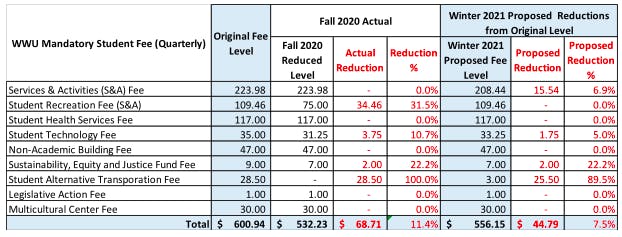Board of Trustees pass 7.5% reduction for winter 2021, less than fall 2020 11.4% reduction

By Ryan Morris
Western Washington University students each saved $68.71 in fall 2020 mandatory student fees due to online learning but will save less in winter 2021.
Each year the Board of Trustees approves the number of mandatory fees for Western students, but this year student fees are changing each quarter, said Western’s Director of Communications Paul Cocke in an email to The Western Front.
In the 2020-21 academic year, each student was expected to pay $600.94 per quarter in mandatory fees, according to the mandatory fees 5-year summary. After reductions, students paid $532.23 in fall 2020 and will be paying $556.15 in winter 2021. According to the summary, these fees are the cheapest since the 2016-17 academic year.
Faye Gallant, executive director of budget and financial planning, described mandatory fees as any fees all students pay on top of tuition. An example of a non-mandatory fee would be a lab fee paid when registering for a science course, Gallant said.
The varying use of reserves and different programming needs from fall to winter allowed for a higher reduction of fees in fall, Gallant said. Reserves are university savings that Western used fall quarter to aid in COVID-19 losses.
Western’s office of Budget and Financial Planning, along with the Board of Trustees, balanced financial needs of students and the needs of the university, Gallant said. The reductions will not negatively impact the university’s operations, she said.
“The decision was made that this was a level we could handle based on reserves we have and where expenditures did go down, but it is quarter by quarter,” Gallant said.
Lynn Pasquerella, president of the Association of American Colleges and Universities, said state funding plays a role in the reductions universities can provide their students during COVID-19.
“We’ve seen such a dramatic decrease in state support for higher education,” Pasquerella said. “This disinvestment in higher education means that the institutions are asked to do more with less. The only way to do that is to increase tuition and fees, or provide alternative sources of revenue.”
Students are asking for additional support during the pandemic, such as increased academic and personal counseling, Pasquerella said. These additional supports cost money.
“The hope in this reduction is that the reduction itself won’t have a direct additional impact on services,” Gallant said. “The intent is that the reduction in the fees reflects the change in services that are in place due to COVID-19 health concerns.”
One example of balancing the university’s needs during COVID-19 is the student technology fee, Gallant said. Western cut this fee by $1.75 per student, the amount for an on-campus printing quota. However, the university is spending more on technology to provide laptops and Wi-Fi hotspots to students in need.
Student voices played a key role in re-evaluating this year’s fees, Gallant said. Many students and their families had questions about costs. Cocke said student voices on committees, such as the Board of Trustees, were also critical to the fee reduction planning.
Second-year Western student Kaelee Bergsman said she’s relieved Western is attempting to help students in their financial hardships, but she wishes they could do more.
Her biggest concern isn’t the amount of the reductions, but the university’s communication, she said. The university hasn’t fully explained where fees are being used during the pandemic, such as the recreation fee, which costs students $109.46 and was not reduced for winter, Bergsman said. The recreation fee was reduced to $75 in fall.
“They’re not using the money in any visible way for [students] to see it,” Bergsman said. “It can be disheartening.”
Bergsman suggested Western re-label and further break down the fees to better show where the money is being spent during COVID-19.
Gallant said Western is providing more reductions than other public universities in Washington. The Office of Budget and Financial Planning reached out to other universities to compare cost-saving measures, Gallant said. This has led Bergsman to be grateful for Western’s support throughout the pandemic, she said.
“Overall, I am very thankful that they took the time to discuss cutting fees and that they are allowing vocality on it,” Bergsman said. “They are considering that their students are asking for help.”
Pasquerella said she recognizes the advantages of reducing fees for students, but student fees also keep universities afloat during COVID-19.
“[Student fees] are vital, particularly now as we’re seeing a reduction in revenue due to declines in enrollment and fewer students taking advantage of residential options due to COVID-19,” Pasquerella said.
She believes cutting student fees can help provide accessibility to higher education and aid students who are facing financial hardship, Pasquerella said.
“Colleges and universities need to play a leadership role in reducing costs and meeting the demands of equity,” Pasquerella said.
Reductions are not confirmed for spring 2021, but Gallant said there is a team of administration looking into it. Gallant explained fee reductions are dependent on university operations and safety measures in response to COVID-19. Western’s Incident Command Structure, which makes the safety recommendations for in-person classes and other restrictions, will first have to decide at what rate classes will continue online. Fee changes will also be considered for summer 2021 if necessary, Cocke said.
Pasquerella said these changes are not only necessary during COVID-19.
“COVID-19, the ensuing financial crisis and this moment of racial reckoning in our society have presented a challenge for all universities,” Pasquerella said. “But it also presents an opportunity for us to reimagine higher education in a way that takes equity into account.”





